► BMW M3 takes on 911 icon
► Sports saloon vs thoroughbread
► Can one reign supreme?
The BMW M3 has always been above the saloon riff-raff, preferring instead to mix it with blue-blood sports cars. New M3 meets Porsche 911 and heads for the hills.
Pre-flight briefing: BMW M3
Why is it here?
Because this is the new M3 – the latest in a long and lauded line of outstanding performance saloons from BMW’s M division. Compared with the previous car, the new one, based on the G20 3-series, is bigger, heavier, stiffer, runs bigger tyres and gets a load more power: 503bhp from a twin-turbo straight-six.
Any clever stuff?
Plenty, much of it focused on preparing the base G20/G22 platform for life in an M car. In go braces to lock the front shocks together, new elements to tie the lighter, stiffer front subframe to the reinforced engine bay, and underfloor shear panels, for the kind of twist-resistance beloved of racecar engineers. In total there’s 38kg of reinforcement, a penalty the team behind the car describe as an investment. Up front there’s the proven S58 six, with its twin turbos and racecar-style closed-deck construction. The M3/M4 also gets a version of the M xDrive system that works so well in the M5 Comp.
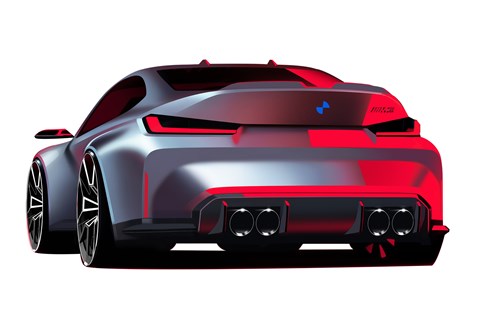
Which version is this?
There’ll be four bodystyles: saloon (the M3), coupe (the M4), convertible and a Touring (which the US won’t get). While BMW’s design team has worked hard to put clear water between the 3- and 4-series, M division has worked to make the M3 and the M4 feel identical to drive. Other markets will also get a less powerful version, for which a manual ‘box is an option, but the UK only gets 503bhp Comp cars and their eight-speed auto. Our M3 is loaded: M Pro ceramic brakes, M Carbon exterior styling pack, HUD, ‘826 M’ forged wheels (19-inch front, 20-inch rear) and Isle of Man metallic green paint – a total of £94k, give or take.
Pre-flight briefing: Porsche 911 Carrera S
Why is it here?
Because the 992-gen 911 remains the definitive four-seat performance car, and because the M3 and 911 grudge match pre-dates the fall of the Berlin Wall. Yes, the 911 is a sports car and the M3 a sports saloon, and yes the Carrera S is some £20k more expensive than the BMW, but if the non-S Carrera (£82.8k) is closer on price it’s also out-gunned, mustering just 380bhp to the M3 Comp’s 503bhp. The £94k PDK Carrera S brings 444bhp to the party and, courtesy of its lighter weight (1515kg DIN versus the BMW’s 1730kg DIN) and rear-engined layout, pips the more powerful M3 Comp’s 3.9sec 0-62mph by 0.2sec, or by 0.4sec with the Sport Chrono Package.

Any clever stuff?
The 992-gen 911’s body is aluminium-intensive (where the 991-generation’s body was 63 per cent steel, the 992 is just 30 per cent steel, and the outer skin is all aluminium), more rigid than the previous car and wider. Track widths are up at both ends (by 43mm at the front) and rubber is wider than before, and on bigger rims (20-inch fronts, 21 at the back). While the engine is a 3.0-litre six like the BMW’s, it splits its cylinders into two banks of three and lays them flat. It also makes less power and torque.
Which version is this?
The Carrera S, so the more powerful, rear-wheel-drive base 911 variant, in coupe form. This car’s sweetly optioned with Racing Yellow paint, the PDK ‘box, PASM suspension (£665), RS Spyder wheels (£1650), Sports Plus seats (£324), Sport Chrono pack (£1683), £1844 sports exhaust and rear-wheel steering (£1592).
M3’s company
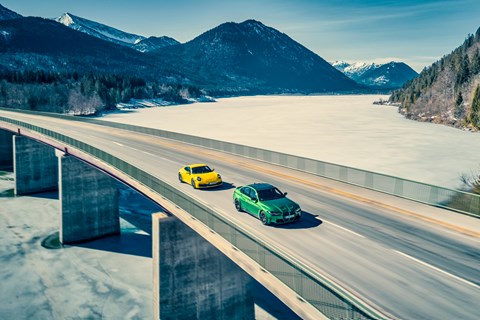
Perhaps it’s a small, mostly harmless manifestation of our all-consuming desire to impose order on the natural and fairly chaotic way of things, but there’s something deeply attractive about a round number. 176mph, 177…
Hands fight to stay relaxed on the BMW’s steering wheel. My attention is focused so intently on the speeding grey scar of autobahn ahead that I think my conscious self left the steel-and-aluminium confines of the M3 a while back – it now gazes down on the world and this shimmering emerald projectile as if from a drone. Munich grows small behind us and the mountainous Austrian Tyrol draws closer at a quite breathtaking rate, the M3 Competition’s throttle pedal at the full extent of its travel with a level of commitment that surprises even myself – and it’s my leg.
179mph… 180mph. The neat sense of order does not last. 181mph… 182mph. Er, you what? Still the M3 Competition’s 503bhp six pulls, still the car’s speed-sculpted aero and uncompromising chassis set-up feel unperturbed… and still the yellow Porsche shadows us. Put the numbers down to an over-optimistic speedo if you must (and we probably should; M division claims 180mph for its new baby with the limiter lifted), but this apparently pointless exercise in excess has at least disabused me of the notion that this new M3 – a car we’ve heard so much about for so long – deserves to be considered in any way evolutionary or familiar. It is new, and it is clearly very, very serious.
So prolonged was the wait that we had worried. In the same way you can feel you know someone just because you once read an interview in a Sunday supplement, and may, if you ever pass them in the street or queue behind them in an airport terminal, feel compelled to wave and say hello to a complete stranger, so the new M3 felt somehow safe despite being more of a clean-sheet generational re-boot than the current, 992-gen Porsche 911 represents over its 991 predecessor.

Fortunately, much as a shipwrecked soul carefully hoards rainwater and fruit, so the M division faithful have spent the weeks and months diligently gathering reasons to be positive. This current, G20 3-series impressed right from the start (BMW deemed even the non-M3 early cars sufficiently quick and complete as sports saloons to be launched on the Nürburgring…) and, with that hurdle – the acquisition of a sound base car – cleared, M enthusiasts, like the chiselled surfer-hero in a Guinness ad, just waited.
Hybridisation? The rumours came, caused a few sleepless nights, then went – ‘too soon’ said BMW, noting that batteries are still too heavy. All-wheel drive? Atriums and ventricles momentarily froze with panic as visions of corrupting torque-steer and numb power-understeer stalked our nightmares. But then we remembered that the M5 Competition uses M’s xDrive four-wheel drive, and that it’s sensational. No more manual gearboxes? Half true – there will be, but not for the UK, since we’ll only see the more powerful Competition variant, and its powertrain is too much for the delicate stick-shift ‘box. A Touring? Ask and you shall receive – for the first time in M3 history, an estate version is coming.
But all of that’s for another day. This day – this perfect late-winter day of dizzyingly bright light and almost-warm, definitely-dry blacktop – is all about this car, our Isle of Man Green, rear-wheel-drive M3 Competition. Dialling back the pace to preserve some fuel, there are a couple of gripes in among the mostly positive first impressions. This car has the carbon-ceramic brakes, which feel like a deeply sensible if still painfully expensive idea on a car this fast and this heavy. But I can’t shake the sense that they’re a little low-tech and sleepy when cold. Get a decent stop under your belt and they’re superb but, like a hungover head in search of coffee, they’re less impressive when first awoken. BMW also insists on endless set-up options, too, so you’ve a choice of Comfort or Sport brake settings – how about just one, called ‘Perfect’?

The steering too has me thinking about it, which is never encouraging. It’s a little nervous around the straight-ahead position, certainly at big speeds, and it doesn’t like rough roads. Does a switch from Sport to Comfort help? A bit, but not enough. Even though German highways like this one are typically flat and smooth, there is too much interference filtering back to my palms, an issue that didn’t manifest itself on earlier (and mostly wet) racetrack-based prototype drive opportunities. Perhaps this abundance of feedback, distracting and confidence-sapping now, will enthral when we get into the hills.
With Tyrol off-limits due to Covid rules we make for the stunning Sylvenstein reservoir before curving back to Bad Tölz and heading for more mountains – Garmisch-Partenkirchen’s towering backdrop, with the mighty Zugspitze towering clear of the peaks around it. The roads are mostly empty and they are mostly sensational, with every kind of corner and complex imaginable. We also have the kind of grip levels 500bhp and a single driven rear axle consider pretty much mandatory.
Now that we’re here, the M3’s front end (the standout memory from those early track drives) does not disappoint. Yes, this car’s relentlessly quick between corners and braking events. And yes, it makes some really quite exciting noises (not all of them real, if that bothers you). But
what really marks this M3 out (and gives credence to M division’s assertion that it benchmarked the new Competition against the outgoing M3 CS) is the confidence and speed you can carry into corners; even corners you’ve never met before.
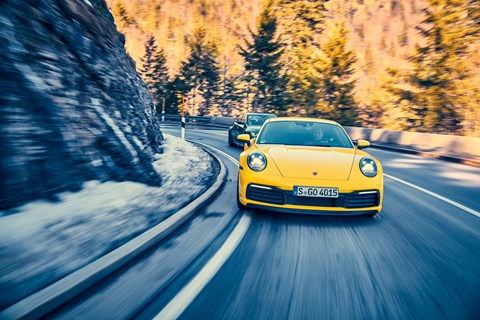
Turn-in, despite the engine being positioned ahead of you, is as brisk and as positive as you could wish for. If anything, the feedback is now meatier, marginally more positive and better grounded than on the previous car, feeling more like – that car again – the previous-gen CS: a good thing. There’s a faintly astonishing amount of front-axle bite, the tyres (275/35 ZR19 Pilot Sport 4S Michelins, with 285/30 ZR20s at the back ) hanging on and encouraging you to brake only to settle the nose, rather than to actually meaningfully reduce your speed.
So, is the same steering that felt too jumpy this morning but pretty damn good on a track a couple of months ago perfect here? It is not. For me, even in Comfort mode it’s too nervous and too easily upset by the road surface. It feels like a system calibrated for a track, and there’s a kernel of truth in that. This kind of razor-effect responsiveness – more pronounced still in the Sport setting – is key to ultra-fast laps on the Nordschleife, but it’s an R&D direction that presents the committed road driver with a dilemma: dial in a bit of confidence-boosting slack with Comfort or stay in Sport and work on delivering less flamboyant, more measured inputs. With time, it almost works.
And those carbon brakes? They’re hot and happy now, as impressive deftly loading the front axle on turn-in as they are dragging us back down from speed when that looming right-hander develops into a hairpin, not a dab-and-go sweeper.
Backing off a moment, to gather thoughts and cool cars, there’s time to take in the cabin. If the M3’s pricing has kept pace with its soaring
ambitions, know that at least this feels like a cockpit worthy of a car with a street value of some £94k. It epitomises modern sporting luxury, and feels so premium you have to remind yourself that the G20 3-series is also available as a £35k 318i with a raging 156bhp and fabric-covered seats.
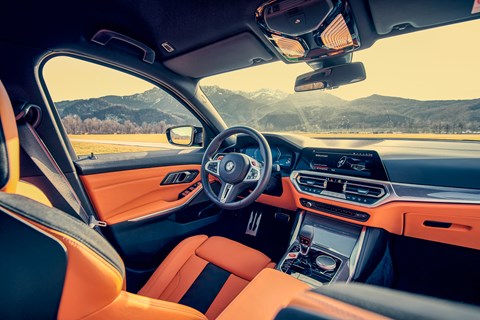
The soft two-tone leather – in our case black over orange – covers virtually the entire cabin with the exception of roof, floor and sills. Glittering aluminium trim adds a lustrous touch. And crucially all three available displays (optional head-up display, driver’s display and centre touchscreen), the iDrive controller and the direct-access buttons grouped around the gearlever are all intuitive to use and receptive to the spoken word. Standard equipment leaves very little to be desired, and I prefer the bright red M1 and M2 buttons on top of the M3’s steering-wheel to the Porsche’s solitary drive-mode controller because they give you more options. In the 911, Individual mode accesses a single setting compiled to the user’s personal preference. In the M3 you have two such options. M1 can, for example, trigger your waft-home programme, perfect for a couple of phone calls followed by Messrs Harman and Kardon’s finest aural indulgences, while M2 can harbour the exact opposite: the fastest shift speeds, a low traction-control threshold, uncompromising dampers and the engine and transmission in their most playful mood. So, the M3 is a fabulous place to be and tough to leave. But leaving it for a Porsche 911 Carrera S is such sweet sorrow.
Ah yes, the Porsche. Every M3 has had its 911 to face, and historically the BMW’s delighted in its underdog role; more affordable, more accessible, often more powerful. And while both have evolved, growing bigger, quicker, heavier, more complete and incomparably safer, some things never change – great M3s must still bear comparison with Stuggart’s ever-changing constant.

Stepping down from the M3 into the ground-hugging Porsche makes you wonder at the 911’s enduring popularity with retired gentlemen racers – how do they climb in? The hip-point is low enough to have you fearing for gravel rash to your buttocks, and the standard seat feels neither particularly comfortable nor all that supportive. A point to the M3. (Incidentally, the M3 is available with a far more serious seat – BMW’s DTM-esque, weight-saving and harness-ready carbon M buckets, part of the £11,250 Ultimate pack or £3400 on their own. Even BMW admits getting in and out isn’t easy, but worth the effort.)
On the move again, the green machine ahead ripping to the horizon in a wake of winter road dust and atomised Michelins, the roads are smooth like silicon-soaked soap. Still neither car rides them particularly convincingly. The Racing Yellow bird is firm by birth, the greenling firm by fine tuning. The Porsche’s tautness is further accentuated by the wider wheels and tyres and by the scalable damper control, which is wham-bang cruel in Sport Plus mode. Ditto the BMW, which also objects to the narrowest expansion joints, starts a fight with every rut it can find, and has yet to agree on the final terms and conditions of any deal in the roll, yaw and pitch departments should the road throw undulations into the mix. So, they’re both firm. Arguably, that’s the point – you’ll need that ten-tenths body control when the excrement is fast-approaching the rotary ventilation equipment. And so it proves.
Because both marques offer more powerful cars, perhaps the temptation’s there to assume that these two are merely adequately rapid. After all, even the Carrera S lives in the foothills of Mount 911, and nowhere near the rarefied summit. But write these two off at your peril.

The Porsche flat-six is a lovely engine which makes wonderful noises, evinces a Dobermann-like throttle response and features an Everest-inspired power curve – an effect exacerbated by typically rangy gearing. With the Sport Chrono pack and flawless PDK ‘box in place, the Carrera S is searingly fast in reality, driving hard out of corners and piling on speed with an alacrity that, if anything, makes its official acceleration times feel pessimistic. That its 0-62mph time is just half a second down on cars like the M5 CS and McLaren Artura serves to underline both the speed of the Porsche and the truth of the concept of diminishing returns.
Similar praise should be heaped upon the finest-ever straight-six to come out of Munich. The M3’s engine kicks harder than the 911’s, nearly spins as fast (7200rpm to the flat-six’s 7500rpm) and brings a decent torque advantage, the better to offset the BMW’s pudgier kerbweight. Of course the Porsche is lighter – it has just the two doors and a token pair of rear seats – but curiously the difference is not as marked as you expect from behind the wheel, helped by the BMW’s stronger engine and sweet balance. Consumption? The official thirst ratings are 26mpg (911) and 28mpg (M3), but as soon as the hooligan with the self-cleaning driving licence sets the pace, the Porsche drops south of 20mpg as surely as the M3 nears 16mpg. Could the difference be down to operator enthusiasm? It might, but that doesn’t account for the disparity entirely.
Dynamically, the Porsche is hard to fault. It talks to you via lovely steering and seat-of-the-pants feedback, it has an amazing set of brakes and it’s punted along by an iconic engine that feels as charismatic as ever. It edges the BMW against the stopwatch and on your favourite Sunday morning speed stage, its wafer-thin margin of superiority a product of some fundamental engineering advantages and a wholly cohesive driving experience in which no one element distracts or dominates.
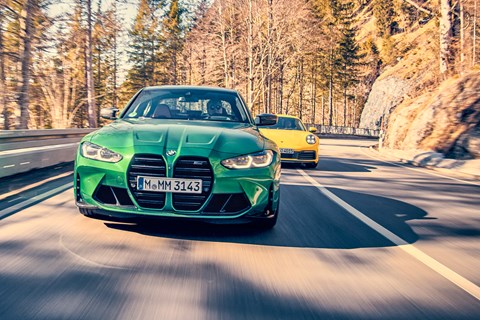
Wafer-thin? It really is. Back on the road, working hard at the 911’s wheel to maintain that smooth-but-committed tempo to which the rear-engined machine responds so well, the M3’s rabid acceleration and massively improved, confidence-swelling front-end grip mean the BMW just refuses to grow any smaller in the Porsche’s mirrors. Turn-in in the M3 is more zigzag-direct than ever and, even on surfaces strewn with salty dirt and scattered chippings, through corners of tightening radii and over sudden surface variations, the BMW now simply sticks. And sticks. And sticks – almost to the extent that you forget for a moment that it’s the rear end that’s likely to come unstuck first.
A flaw? No. The new BMW excels at the time-honoured art of fine throttle steer. Select MDM mode and you can set about describing lines spine-tinglingly close to the threshold of adhesion, helped in no small part by the exceptionally intuitive work of the electronic differential.
The 911 has more traction and is less keen on such extrovert exuberance, but it’ll do it under duress.
Mechanically and electronically, the new M3 is a complex animal. It packages no fewer than seven radiators and two separate cooling circuits. Its twin mono-scroll turbochargers have as much plumbing between them as a small city. The multi-talented and watch-like innards of the adaptive M differential are awe-inspiring. And the chassis has special M touches all over it, from under-body shear plates to uprated wheel carriers. But while the complexity is there, should you wish to launch into the available options (or engage the 10-step M Traction Control, which loves to crown drift-masters by awarding up to five stars for the duration, consistency and angle of their slides) you’ll discover an honest, engaging and impressively intuitive performance car in which to have more fun than you might ever have thought possible in a saloon.

The last leg our epic 250-miler is a flat-out stint on the A96 autobahn, summer tyres spinning to a blur and tanks draining to empty as the sun drops to the horizon and this dream day fades to dusk. From the BMW’s cockpit I ponder the Porsche. With its sports exhaust, rear-wheel steering, Sport Chrono pack, RS wheels and partial leather trim, it eclipses the M3 Comp’s list price by an irritating margin. Even when you factor in the higher resale value, the Porsche’s extra credibility in certain circles and the marginally superior high-speed performance, the price differential is painful and must be taken into account. A non-S Carrera 911 shrinks the price gap but lacks anything like the M3’s power, while a Cayman GTS 4.0 is neither capable of carrying sufficient people nor, in fact, a 911.
The usual sparring partners will have their chance, from Audi’s RS4 to the revised Alfa Giulia Quadrifoglio. But in making the 911 sweat the new M3’s cleared the first hurdle to greatness.
Watch our BMW M4 vs Porsche 911 video review here
Final reckoning: value and victory
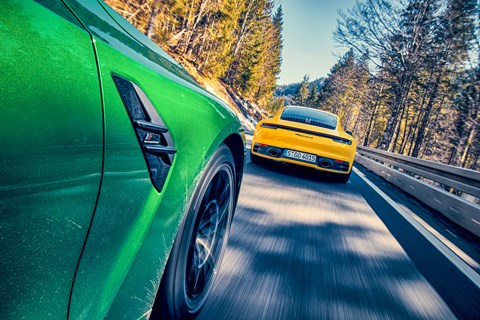
The M3 takes the value-for-money trophy – that is as clear as a melt-water stream. By comparison, the 911 is a disappointing exemplar of extreme de-contenting and almost eye-wateringly ambitious pricing.
If you choose the Carrera S then certainly you can create a more affordable example of the breed than this car, and give away very little in the process. The only chassis-related option to be considered a must-have is the rear-wheel steering. Its almost imperceptible good work burnishes the already agile yet stable 911 with more of both, giving it a crucial edge against the BMW on give-and-take roads. It’s one reason the Porsche manages to feel more firmly planted than the M3 more of the time (the BMW fields an immaculately balanced 50:50 weight distribution), helped of course by that weird but wonderful rear-engined layout.
Forget Porsche’s ceramic brakes unless you’re a trackday regular, and think twice before checking the boxes marked PASM sports suspension, with its 10mm chassis drop (it’s ripplingly firm), and sports exhaust, because however hard everyone tries, the flat-six (now liquid-cooled, turbocharged and petrol particulate-filtered) simply no longer sounds like we remember it. We must accept that.
So, the M3 is more car for the money. The BMW also scores highly for both its increased practicality and more premium execution. The four-door M3 is a true flagship in fit and feel. Love and care is evident all over the thing, from the lush materials of its driving environment to the silken machinations of its powertrain and rear axle.
But the M3 is a fair bit thirstier, its hyper-active steering either needs work or asks that you adapt, depending on how generous you’re feeling, and ultimately, when you’re able to indulge these cars in the kind of driving for which they were surely created, it is the 911 Carrera S that’s able to squeeze out that crucial extra drop of adrenaline to make this the closest of photo-finishes.
It’s a draw. A cop-out? Maybe, but sometimes answers are too complex to be tidied up into binary soundbites. And the truth is the BMW M3 and Porsche 911 have as much in common as they do points of difference. Since first they faced off they’ve changed, almost beyond recognition. But both remain relevant. And both are magnificent.
BMW M3 vs Porsche 911 Carrera S: verdict
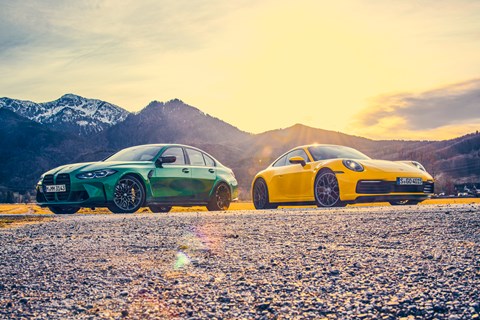
=1st
Porsche 911 Carrera S
We don’t do draws, but this is one – too finely balanced to call. The Porsche, ultimately, can reach higher dynamic highs, but…
=1st
BMW M3 Competition
…Munich’s ferociously fast four-door is better value, has a better interior, indulges slip angles more readily and pushes the 911 to its limits while remaining a practical family car with proper back seats.